-
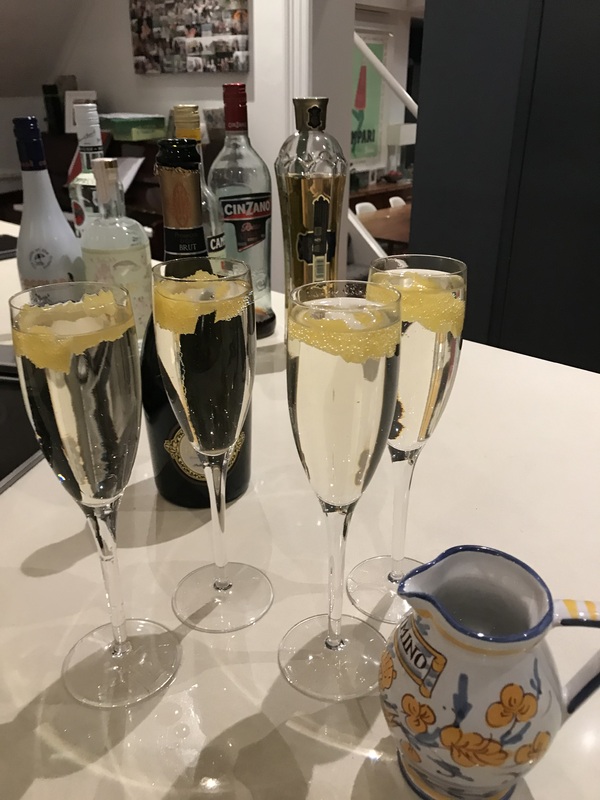
2020-03-31
On 31 March 2022, the first lockdown was initiated in both Melbourne and Sydney. I was in Sydney at the time, having arrived a few days prior from Melbourne as border restrictions were starting to be introduced. I am slightly ashamed to say, now, that I really enjoyed this first lockdown. I hadn't lived at home since 2018, and it was a unique experience to enjoy time together that wouldn't have normally happened. We've always been pretty close, but the lockdown forced an intimacy that we'd never had before (it helped that my teenage brother was required to be at home and boredom had driven him to start having conversations with us again). I think mum and dad were consciously trying to keep lockdown interesting, and soon a weekly cocktail night (with a required lounge formal dress code), bi-weekly painting lessons via zoom and daily yoga with mum, nightly music sessions with dad, lego competitions with the old dusty lego sets, and weekend family walks were introduced. I had never done so much exercise in my life, and yet I had never consumed as much alcohol, either. Even when I lived in a flatshare as an eighteen-year-old. Alcohol quickly became a problem for me, one that I have yet to fully address although I have started to cut down. The taste of wine became associated with fun times with the people I loved, so of course, I loved it. And when the lockdown eventually lifted, I returned to Melbourne nearly friendless (having left before I got the chance to settle in and with little opportunity to meet new people), a cheap bottle of pinot grigio and I became good - if slightly toxic - friends.
-
2020-03-22
I started at Melbourne University in March 2022, moving all the way from Sydney and knowing no one in Melbourne. I quickly made a group of friends at college, but things were still a bit new and awkward - we were in that stage of a new friendship where you are past small talk but not quite at deep and meaningful. Regardless, we decided to take a trip to Melbourne Zoo on the 22nd of March. It was a great day: the sun was shining and the animals were beautiful. We were joking around and it seemed like we were at the start of a really exciting and close friendship.
In the early afternoon, I got a phone call from mum. News had been trickling in over the past month of COVID cases and deaths in Australia, but we still weren't entirely sure how seriously to take the disease, and we were clueless about how it would change our lives. On the phone, mum asked if I had been reading the news. Of course I hadn't. She told me that all non-essential services would be shut down, and that it was likely going to get more strict as the week went on. "I think you should come home. Uni will be online anyway."
The next day, I was on a plane back to Sydney, after only having spent 22 days at college. Never fear, though, I was sure it'd all be over soon.
-
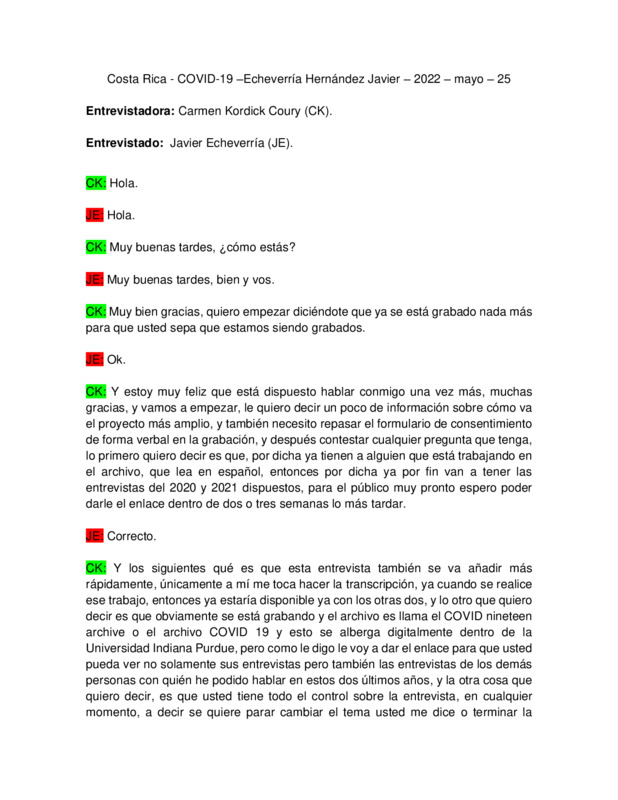
05/25/2022
En esta entrevista Javier Hernández Echeverria es entrevistado por Carmen Kordick Coury concerniente al covid-19 en Costa Rica. Para empezar, hablan de los cambios que habían pasado desde el año anterior. Hablan de la situación en cuenta la pandemia y el programa de la vacunación. Hablan de la gente que aun no se han vacunado por falta de querer. Habla del camino a la normalidad, el uso de mascarillas, del gobierno, y nuevos candidatos. De allí hablan de su vida social, y el concierto de Cold Play. De La Caja, las elecciones, y el seguro social. Otra ves vuelven al tema de las vacunas, de gente que no se quiere vacunarse, de la familia de Javier y las noticias falsas. Habla sobre su vida ya jubilado, de la economía y inflación y gente sin trabajo. Para terminar, hablan de fuentes de información, de las elecciones y el nuevo gobierno. Al final habla del futuro.
-
2020-05
During the pandemic it was certainly a struggle for all of us. In my rather large town called Hilliard, many didn't take the pandemic seriously. People straight up just did not care about what was going on, and were even convinced it wasn't real. Even students were denying to wear masks in school. When in came to the point of complete isolation people were surprised, as if they didn't see it possibly happening. I want people to know that this is pandemic is 100% real and it cannot be taken lightly.
-
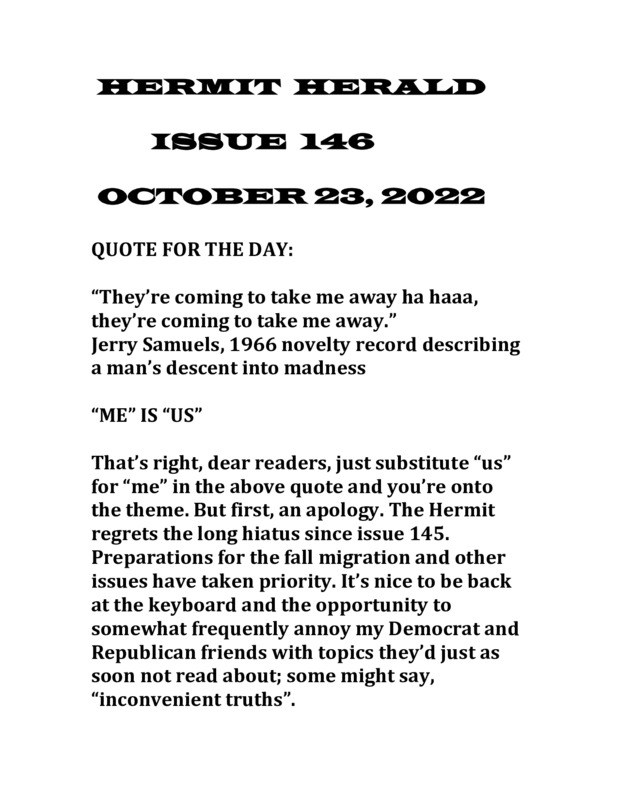
2022-10-23
DEMOCRACY AT RISK
-
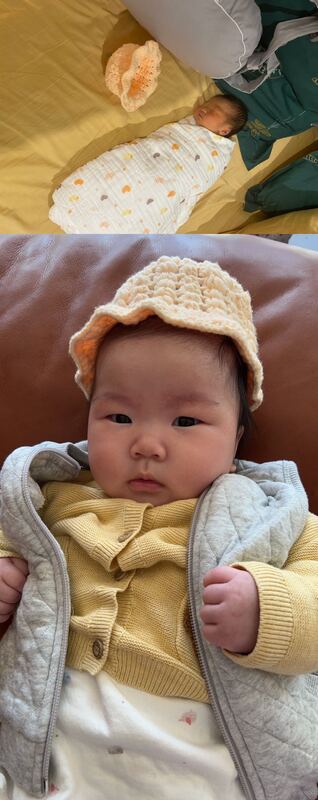
2022-10-20
Me and my sister have been wanting to go back to China for quite some times now – we haven’t seen our grandparents for years due to the pandemic, and they are not getting any younger. But the crazy flight ticket price and the concern that China’s strict covid policies will make it hard for us to come back for school made us postpone our plans. It is also difficult for them to come here, also due to China’s covid policies.
This June, my cousin gave birth to a girl, whom her grandmother and great-grandparents deeply wanted to meet. The pandemic born baby is growing very fast: she used to be too small for the hat that I knitted for her birthday, but now she’s already too big for it.
-
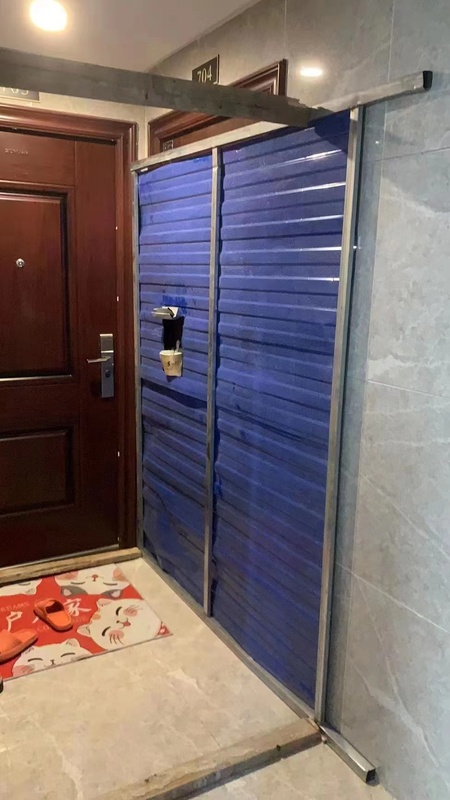
2022-10-10
A door in the neighbourhood is nailed, to stop people with positive cases from going outside. I found it a bit uncomfortable, and I really feel sorry for the people inside.
-
2022-09-09
Early September this year, my uncle Kun Ye went on a business trip to Xinjiang. Unfortunately, as he arrived, positive cases were starting to pop up in the region. He quarantined in the hotel for 20 days, waiting patiently, hoping the situation to improve so he can get his work done. When it got closer to October, a friend in the local government gave him a call, advising him to return to Hubei asap, otherwise it will only get harder and harder for him to go home.
He took that advise and flied back to Jingmen, Hubei, it turned out to be a smart decision. By the start of October, no more flights were either going to or from Xinjiang. The whole region went into quarantine, and people was told by the local government to prepare for up to 7-10 days’ worth of food and other necessities, for the upcoming lockdown.
After Uncle Kun’s arrival to Jingmen, he was told that since he just came from Xinjiang, a place with growing covid cases, he must first go to the square cabins and quarantine for a week. “Life was so bad there”, he told me: “the meals hardly had any meat.” Well, he was a meat lover.
That was not the worst for him. During his isolation, cases appeared in Jingmen as well, (since they just accepted a flight from Xinjiang). A case was found in “Kailin Park”, the community which he lived, and the whole Kailin Park was locked up by blue iron walls, people can neither get in or out. With no home to return to, Uncle Kun went to our house; and since I was studying overseas in Australia, he slept in my empty room for a week. Frustrated, he told me over the phone, that “so much time was wasted last month, and nothing was done.”
-

2022-10-10
A road near my home in China is closed. Workers are building a wall across the road to stop any travels. This road had much of my childhood memory: it's very close to the “Palace of Culture”, a Sunday School where many kids went to take math, Chinese, English, art or music classes. On the other side of the road there was my favourite noodle soup shop, also closed.
-
2022-10-14
On Oct. 14th, my dad went to a nearby town called Huji (in Zhongxiang, Hubei province, China) where there is a factory of the company that he works for. He was supposed to stay there for a week. On the 20th, 2 Huji students and an adult tested positive. The whole Huji town quickly went into a lockdown, and all workers, 2 thousand of them, were to be quarantined right there and then. They must stay inside the factory during the restriction, which would last until cases drop to a certain point. (By the 29th of Oct, there are still no signs of any ease on the lockdown).
Food wasn’t a problem, because there was a large canteen in the factory. But there was no accommodation for 2000 workers, only dorm rooms for around 400. My dad had to make quick arrangements for this. Eventually, they bought thousands of mattresses and quilts to make beddings on the floor. These were brought from nearby cities, mainly Jingmen, Jingzhou, and Xiangyang.
My dad was able to leave with a friend who had permission, so he hurried back to our home in Jingmen, where he was told by his friend that all travellers from Huji must report themselves and quarantine at home. But as he planned to go to Yichang for another business trip soon, he pretended that he never knew this information. On that day when he was having lunch, he received a call from the pandemic prevention people, politely asking him about his recent travels. He told them that he will be leaving for Yichang immediately, to which they agreed. Then he dropped his chopsticks and drove to Yichang.
-
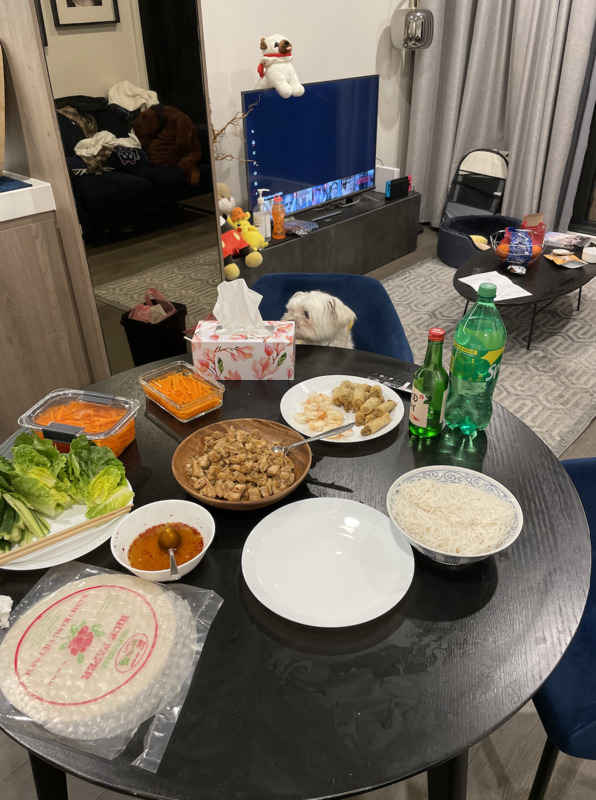
2022-01-02
HIST30060: This was a photo taken before dinner during my self quarantine at the beginning of this year, as I had come into close contact with my mum who had COVID on Christmas day. I was then promptly messaged by the Department of Health and Human Services to quarantine for the next week, which also meant I had to self isolate on my birthday (New Year's Eve). This dinner was the final night of that quarantine, in my apartment with my girlfriend and her dog, eating a dinner we had organised through having our groceries delivered for the first and only time. This quarantine reminded me and still reminds me of the presence COVID still has in our lives even in 2022, years on from the beginning of the pandemic and outside of lockdown restrictions. The virus still restricts us in ways we had not experienced before 2020.
-

2020-06-06
HIST30060: This photo was taken at the Melbourne Black Lives Matter protest in June of 2020, it was one amongst the wave of protests taking place across the world sparked by protests in the United States following George Floyd's death at the hands of the police. It was the second protest I had attended and the sheer number of people attending to show solidarity with people of colour in the US and shed light on police issues at home was an inspiring sight despite the harrowing reality of it all. Figures such as the Prime Minister at the time cited health risks as reason to not demonstrate, but this potential of COVID spreading however was consistently weaponised by conservative pundits (despite their consistent calls for lax restrictions). to discredit the movement.
-
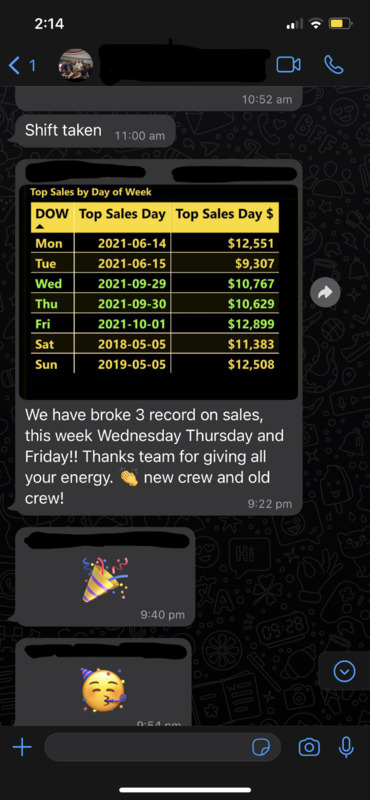
2021-09
HIST30060: This is a screenshot of a whatsapp group chat for the workplace I was in during the sixth COVID lockdown in Melbourne. Despite restrictions being at its highest at this point, the profits for my workplace broke new records this week, similar as to how other major companies raked in major profits during the lockdown era. I remember working that Wednesday night, me and the few coworkers I was with were inundated mostly by online delivery orders but there was still a steady stream of customers coming in (quite often without masks) to order in person. There was little reward for our efforts, but at the very least I was afforded some peace and quiet on the commute home with the lockdowns in place.
-
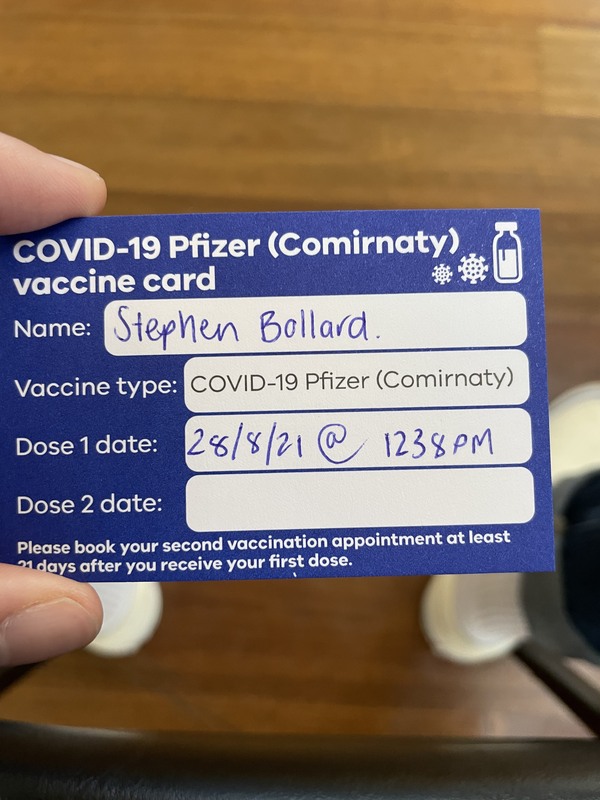
2021-08-28
HIST30060: This is an image of when I was waiting to leave the Royal Exhibition Building following my first vaccination. The experience was not something I was unfamiliar with, throughout high school I received regular vaccinations, the only downside this time was there not being a bowl of lollies to reward myself with as there was during high school. I had been anticipating the worst of symptoms after what I had heard from others, but fortunately all I really got was a stiff arm. This was also amidst the beginnings of the anti-vax movement and protests that we unfortunately are so accustomed to at this point.
-
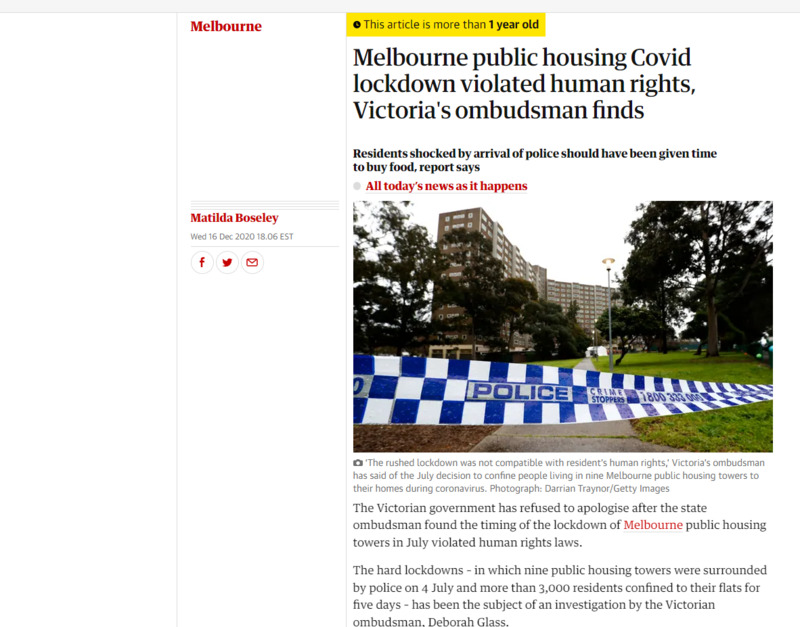
2020-07-04
HIST30060: Just before the second lockdown in Melbourne I was told by my mum that my grandfather and step grandmother had been suddenly without warning placed into a sharp lockdown within the public housing they resided in. The confusion and anger was quickly shared by my family and extended family members, where was the consideration for some of the most vulnerable members of the community, who in some cases cannot speak english? Why were they subject to such harsh conditions whilst those in the wealthy inner east free to enjoy themselves despite their equally high rates of covid? This was noticed by me as well in the harsher treatment of those in the poorer, diverse suburbs of Sydney and Melbourne during some of the worst times of the pandemic.
-
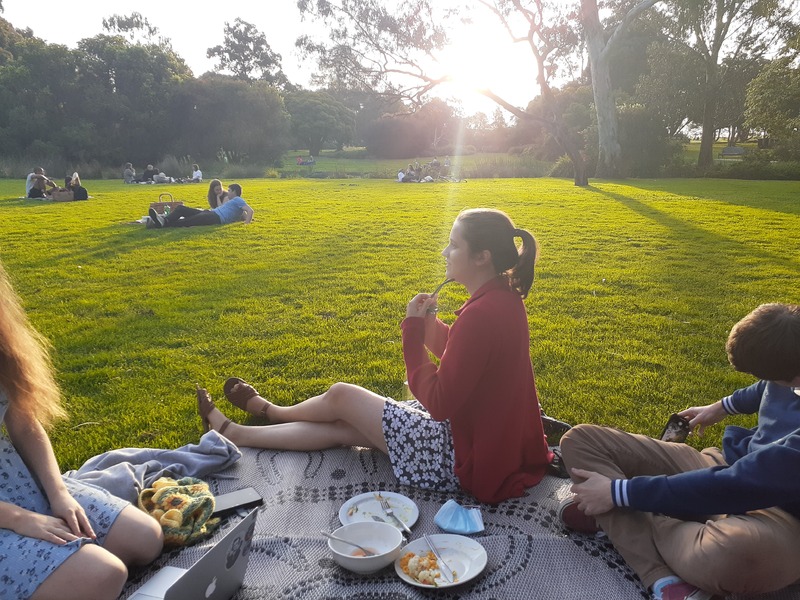
2021-10-20
This was a more joyful moment from lockdown. For long periods of Melbourne's lockdown a picnic in the park was the only way to catch up with friends. It became a very popular activity for my friends and lots of other people in Melbourne. Every evening when the weather was good the parks would be full of groups.
-
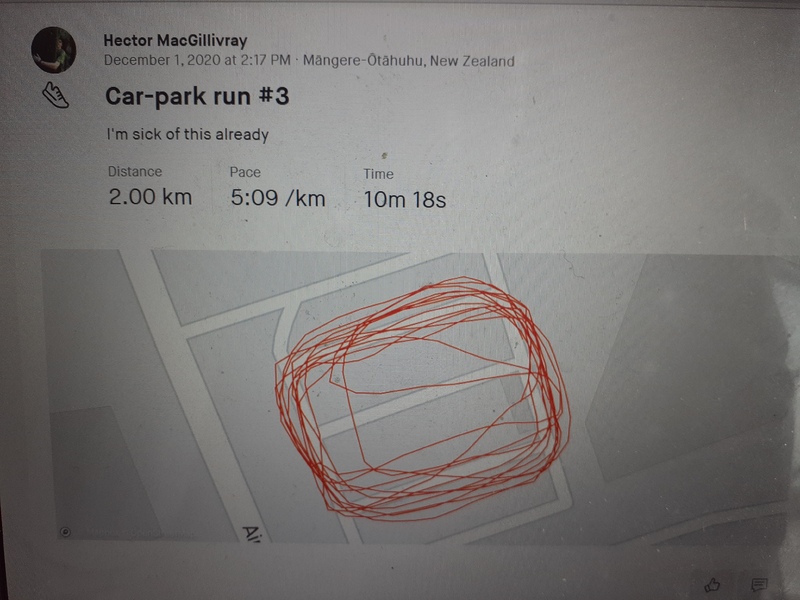
2020-12-01
To return to New Zealand in late 2020 I had to complete 14 days of hotel quarantine. Luckily, my hotel had a fenced off area of the carpark that we were able to use for exercise for an hour each day. This strava activity shows a run I did around the very small carpark (one of six during the two weeks), which involved running in my mask and staying a few meters from the other people in the space. Without these bursts of activity, two weeks in a hotel room would have been much less bearable.
-
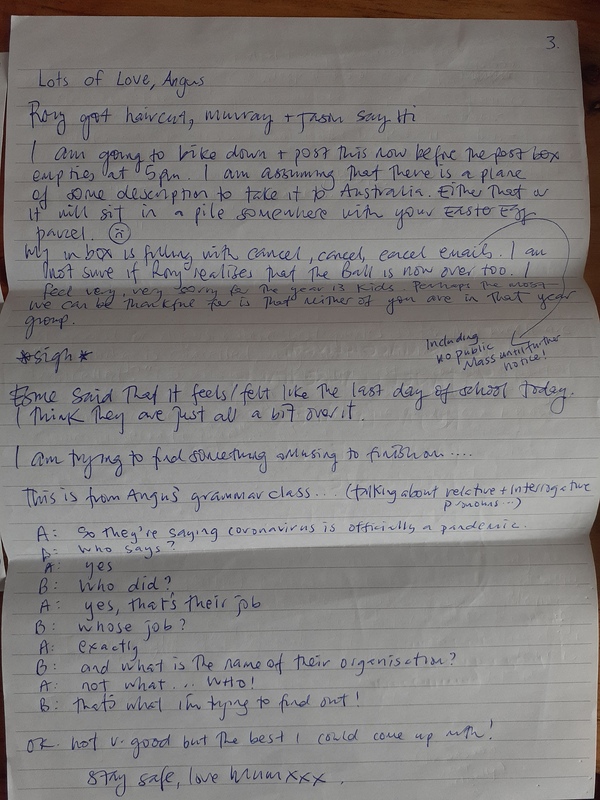
2020-03-20
With lots of extra time to spare during the lockdowns, my Mum started writing letters to me as a way to share news. This was a lovely way to stay in touch between Australia and New Zealand, although by the time the letters made it through the very very slow postal system they were weeks out of date. This particular letter from the very start of the pandemic captures the novelty and chaos of the situation very well -- most events are starting to be cancelled, the border between NZ and AU has shut, and everyone is slowly coming to terms with what's happening.
-
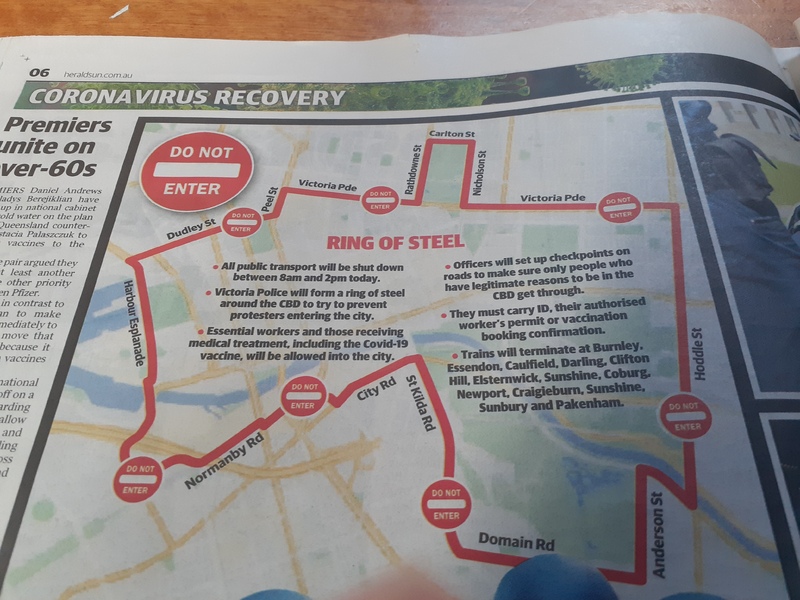
2021-09-18
This photo shows a newspaper article published during Melbourne's 2021 lockdown. Following significant anti-lockdown protests in the CBD, the police enacted a 'ring of steel' around the CBD to prevent further protests. I was actually turned around at one of the checkpoints (unaware that the city had been shut) earlier that morning on my morning run. This was one of the most dystopian moments from the whole pandemic and highlighted the lengths the government was willing to take to stop the protests in Melbourne.
-
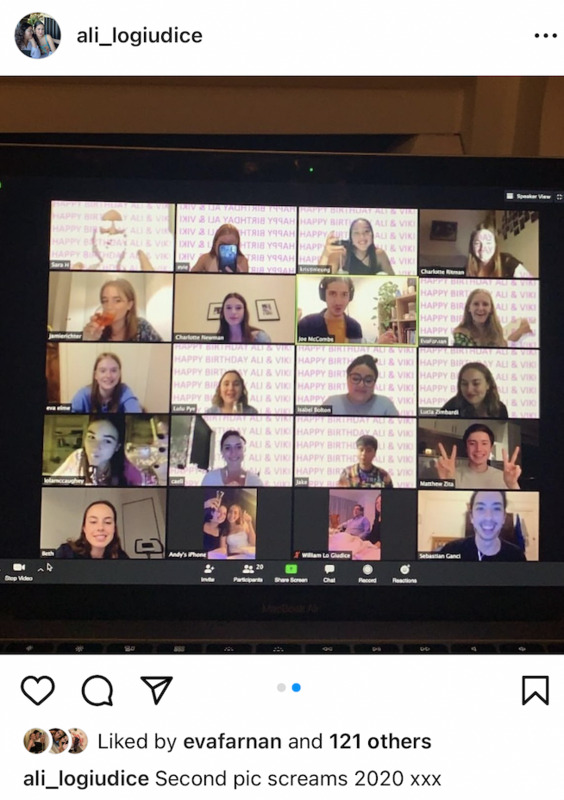
2022-10-31
I’ve selected 5 different photos which give a little insight into being a tertiary student during the COVID19 pandemic. I started my Bachelor of Art degree in March of 2020, fresh out of high school. I was so incredibly excited and had a great first few weeks (I think one or two) and O-Week. I was lucky enough to go on a first year Arts student camp in February, where I made a handful of friends that I am still close with today; it was this small social interaction that really served as the bulk of my Uni social life for my degree because ‘going online’ severely stunted my ability to connect with new people. In the screenshot of a Zoom conference call, I am having a zoom call with some of the people I meet on this camp, a kind of ‘reunion’ during the first lockdown in 2020.
Reflecting on some of the other limitations on the social life of a young student who is very social, I have included a screenshot of an Instagram post I did in April of 2020. It was my 19th birthday, and my ‘obligatory’ birthday post for the year looked a lot different to other years. Rather than being out celebrating with friends in real life, we did a group zoom call where we sang Happy Birthday and my friends watched me cut my cake through a screen. Some people got dressed up, donning dresses and a full face of makeup, to just wash it off when you clicked the camera off for the night. It was lovely to connect but looking back at these pictures now just leaves me with a strange, eerie feeling.
I have included a picture of my university set up, a table in our garden and my dog, Margot. I found it really hard to study in my house all the time, so I would often try to move around to different study zones in my house. I really focused on my study during lockdown, it felt like it was a productive use of time and something I could channel my thinking into. However, thinking so much about University, and always having it in my home (it was not like I was moving between a ‘home space’ and a ‘study space’) was really tiring and draining. Every day just felt the same. I have decided to take a gap year next year rather than moving straight into post-graduate study because I don’t want to feel that same kind of burn-out again.
Finally, I have two pictures which encapsulate some pass times during lockdown. One is my sister painting my bedroom walls; we did a lot of home improvement and beautification, giving ourselves little tasks and jobs that we could complete and feel satisfied with. The other picture is my sister and dog on the beach during a winter’s eve walk. I included this picture because her mask is visible. This picture was taken when there were restrictions about the quantity of family members you could walk with, the time you could leave your house, the necessity of wearing a mask and how far you could go from home. When this picture was taken, we had a curfew in place in Victoria (I think you had to be home before 10pm), you could only walk with household members, but only in groups of two at a time, you could not go further than 5km away from your home and you had to wear a face mask even when just walking your dog to a quiet beach. Reflecting on these harsh rules and the feelings I had at the time makes me feel quite sad as I feel like I missed out on so many experiences that I was promised with my university degree.
My experience as a Bachelor student was so far from what it should have been; so while I am extremely proud to be graduating in a few weeks, proud that I loved what I studied, felt empowered by what I learnt and feel like my academic skills have improved so much, I feel sad that I missed out on social connection, a sense of belonging to a school community, meeting people who are outside my regular circles, experiences with clubs and teams, not being able to use campus facilities and spaces. I am so lucky that I was extremely privileged in the lockdown, my family was all healthy, safe, we had minimal arguments, and they made me smile despite the circumstances; my friends were beyond wonderful, and I had a safe place to live and access to my university and learning online. But when I think back to the lockdowns and the impact of them, I still can’t help but get emotional. More than anything, I always find myself shocked about what we all went through and how unique it was.
-
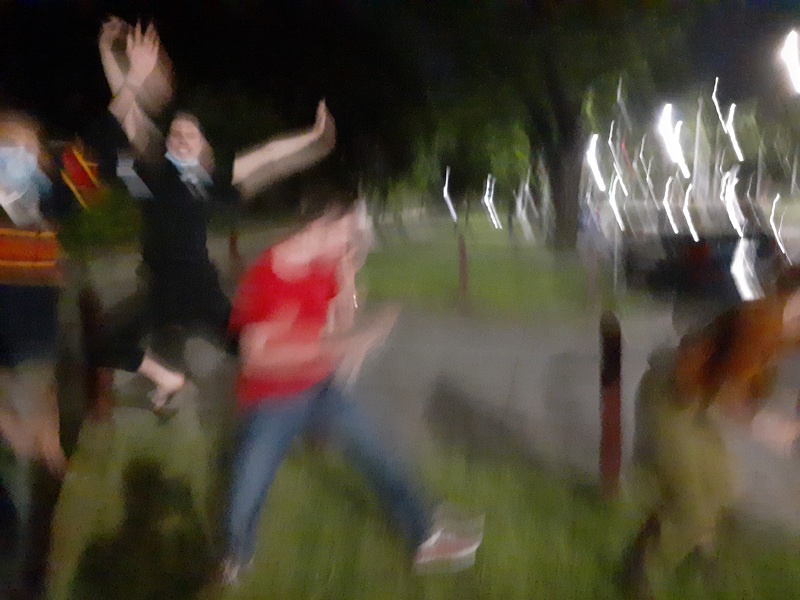
2021-10-22
This photo was taken just after midnight on October 22 2021, after the end of Melbourne's final lockdown. With the curfew lifted and fewer restrictions on leaving home we took the opportunity to come out at midnight and celebrate. This photo captures the excitement of the moment, which finally felt like we coming to the end of the most difficult period of the pandemic.
-
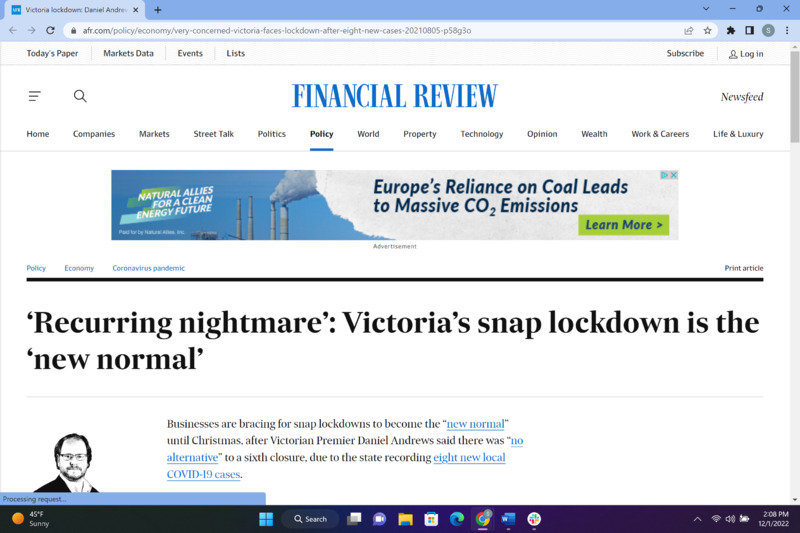
2022-10-30
The recent Covid-19 pandemic has had immense local and global ramifications, especially for us Victorians who have experienced the world’s longest lockdowns. It was a significant worldwide event which will certainly be looked back upon by future generations, just as we have analysed previous historical diseases, such as the bubonic plague. But how should archivists determine which sources, and likewise which voices should be permanently preserved within the historical record?
Traditionally, an archive is a collection of documents that archivists have selected to be permanently preserved as sources for future historical or other forms of research. Initially, only scholars with an ambition to conduct historical research had access to archives, but their digitisation and free nature have ensured that anyone is able to access the documents they contain online.
However, the process of creating both physical and digital archives is inherently flawed. Archivists have a formidable power to evaluate which sources are “worthy of inclusion”, and simultaneously which ones are not; essentially what compromises the historical record.
Therefore, although archivists are characterised as unbiased and impartial individuals, they are inextricably influenced by “societal biases” in their decision-making, as they simply have to select what they personally believe will have value to future researchers. It has culminated in them privileging and prioritising the voices of individuals within positions power, which has indefinitely created “gaps within the historical record” through inhibiting the voices of those without it.
Rodney G.S. Carter echoes the problem in asserting that the existence of archival “silences” is the “manifestation of the actions of the powerful”, which has a substantial impact on how marginalised groups produce and likewise form both social history and memory. Ariella Aïsha Azoulay has cautioned readers that “digital archives are no exception”.
With this in mind, if we consider the 19-month impact of the pandemic upon Victoria, I am certain that archivists will acknowledge the voices of those within positions of power when determining what sources should be preserved. Of particular importance would be those of primary actors that shaped Victoria’s lockdown experience, most importantly the protagonist of the lockdowns, Premier Daniel Andrews (fig.1).
Figure 1. Video of Premier announcing sixth lockdown, cited in Patrick Durkin, “’Recuring nightmare’: Victoria’s snap lockdown is the ‘new normal,’” Financial Review, August 5, 2021, URL: https://www.afr.com/policy/economy/very-concerned-victoria-faces-lockdown-after-eight-new-cases-20210805-p58g3o.
I am aware of the threat of “information overload” both real and digital archives currently face with an abundance of available sources, but I would argue that the preservation of major political statements alongside previously supressed voices would be beneficial to any archive created surrounding the Victorian Covid-19 experience.
A consideration of the experiences of marginalised voices would be imperative to a future historian, as it would enrich historiography by offering insight into the social-political dynamics of the event, and its psychological impact beyond official government and political documents.
I will now consider the value of this “bottom-up approach” in capturing the Victorian pandemic experience from the viewpoint of the common man, me, a historically marginalised group within the realm of archives.
I personally wasn’t too concerned about the first lockdown and its stage three and four restrictions as they would “flatten the curve” of infectious cases, providing our health system with the best opportunity to tackle the fast-spreading virus. Life as we know it changed though with only four reasons to leave home; shopping, exercise, caregiving, and work. The café I worked at had to shift to “take away only”, as many others (fig.2).
Figure 2. The Food Republic Café, “covid update for customers,” Blackburn, March 23, 2020, URL: https://www.facebook.com/thefoodrepubliccafe.
I was still able to work alongside my barista colleague and friend Max which was pretty good, and I was able to perfect my coffee artwork (fig.3).
Figure 3. The Food Republic Café, “promotional post during lockdown 1” Blackburn, April 8, 2020, URL: https://www.facebook.com/thefoodrepubliccafe.
I was also able to continue exercising and riding my bike, but I wasn’t able to see or visit any friends or family, which initially seemed like a fair sacrifice to make for the health and wellbeing of all Victorians (fig.4).
Figure 4. George Vesnaver, Selfie on bike ride, April 10, 2020, photograph, Main Yarra Trail, Melbourne.
However, after being continuously plunged in and out of lockdowns by the time the sixth one came about, I was very angry to say the least as representative within my covid journal entry (fig. 5).
Figure 5. George Vesnaver, Covid Journal Entry, October 27, 2022, photograph, Kew East, Melbourne.
Laura A. Millar’s observation that “the concept of evidence” must be broadened as opposed to its current restrictive and rigid format adopted by archivists has reaffirmed my belief that my experience and that of other regular people should not be forgotten.
My sources may just seem like information to an archivist because of their form, but they are filled with evidence of this historic moment. Their eternal preservation within an archive would serve anyone wanting to write about the Victorian Covid-19 experience in the foreseeable future. For example, figure 2. would enable one to see how government information was disseminated via social media; the confirming and likewise conforming of political decisions. Figure 3. would reveal the way in which people adapted to Victoria’s first initial lockdown via humour, helping us remember attitudes towards the past event. Figure 4. would showcase a sense of normality during unprecedented times, through an ability to continue exercising. But most importantly the response depicted in figure 5. towards figure 1., a first-hand account of the psychological impact of the endless lockdowns instigated by those with political powers.
Winston Churchill once said that “history is written by the victors”, so considering those with and without power survived the pandemic it seems only fair that all our voices should be recognised in the historical record.
-

2021-08-08
In isolation, I found myself coming closer to my family. I was living in Melbourne at the time, away from my home in Tasmania, but maintained constant connection via video calling and messaging my family. One way I connected with home was by sharing old photos with my sister. This is one she sent me while I was in lockdown. It was taken around 2008. Trawling through thousands of old photos was an easy way to keep occupied during lockdowns, and I’m partially glad that COVID gave me the free time to do so as it was a fun way to bond with family and massage out the homesickness.
-
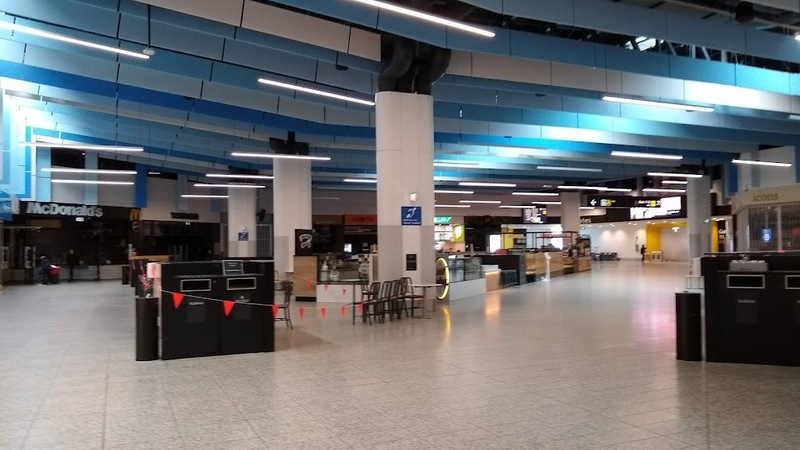
2021-09-16
This is a picture of Melbourne Airport (Tullamarine)’s Terminal 4. I flew out of Melbourne to get home to Tasmania just days before rising cases of the Delta variant forced state governments to shut borders once again. I remember the surreal feeling of passing through the airport then. Without the rush of people, the place felt gigantic. My eyes, typically drawn towards the way I needed to go, were able to refocus towards the ceilings, pillars and billboards. It felt like standing in a cathedral. As I was dwarfed by the sheer size of the terminal, I reflected on how COVID was reshaping billions of lives and world history as a whole too.
-
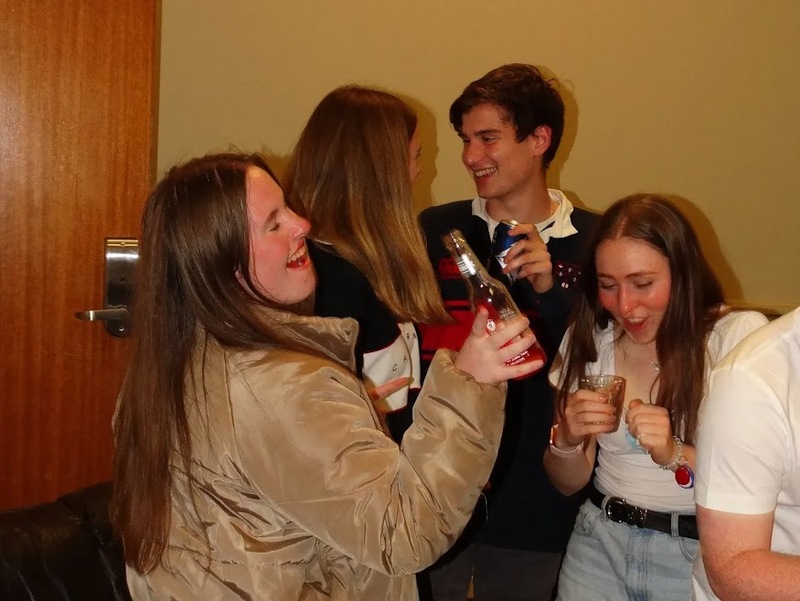
2021-09-15
When the new Delta variant led Melbourne’s COVID cases to explode over the second half of 2021, smaller states looked set to shut borders with Victoria. Consequently, I had to leave my new home at in Melbourne to get back to Tasmania in late September. Not knowing when we’d all see each other again, my flatmates held a small party for me. We stayed up until 4am. This is a picture one of them took at the event.
-
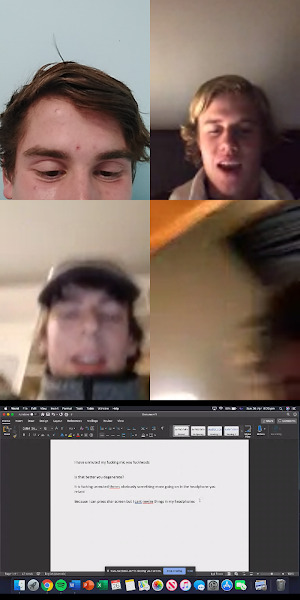
2020-04-05
My 20th birthday party, held on Zoom. We tried to convince George that his microphone was muted, and he proceeded to abuse us via Microsoft word and the “share screen” function. While they didn’t compare to real life interaction, Zoom provided many new creative ways to converse which we had a lot of fun exploring.
-
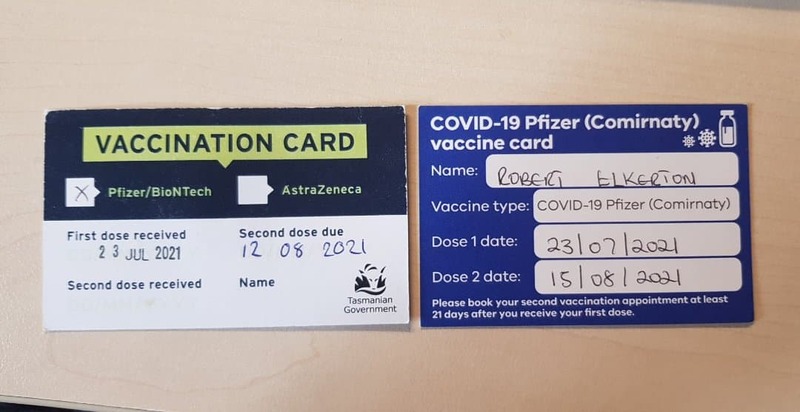
2021-07-23
These are vaccination cards, little pieces of cardboard given to you after a COVID vaccination to both remind you of when your next dose is due and to prove that you got the jab. Legal proof was a major part of the COVID pandemic and perhaps one of its most frustrating parts. I despised incessantly needing to prove that I was vaccinated and without any COVID-like symptoms to do everyday tasks like shopping, visiting the doctor or going to my classes. To make it all easier, I kept these cards as proof of my vaccination.
I also kept them as a souvenir. I was cognisant of the fact that we were living through an event which would alter the course of world history, although I didn’t know how. I thought that they would be a nice piece of material history to show people when they ask what living through the pandemic was like.
-
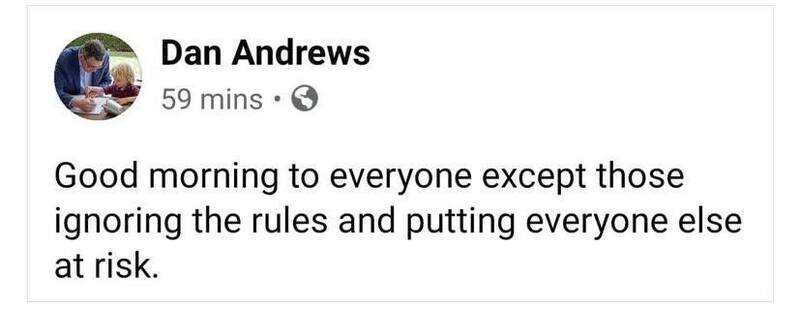
2020-04-04
This is a screenshot of a Facebook post made by Daniel Andrews’ public page on 4th April 2020.
This post exemplifies the Victorian Premier’s ability to co-opt social media trends in promoting his own political agenda. Popular in early 2020, the meme followed the template of “Good morning to everyone except,” followed by exclusion of a relatively a niche social group. This screenshot illustrates the subtle use of social media as propaganda by the Andrews government. Andrews’ social media pages are seldom thought of as such, as the skill of his social media team has allowed him to maintain a popular and likeable social media persona. In an age of ubiquitous social media use, the Andrews government has used social media very effectively to protect its legitimacy and justify its methods. For example, the screenshot highlights the use of guilt by the Andrews government to legitimise health restrictions. The government consistently stressed that the pandemic restrictions were for the benefit of the public and necessitated complete compliance. Those who rejected health advice were endangering the entire community and “putting everyone at risk.” This post therein encapsulates sophisticated government propaganda and the co-opting of social media for political purposes.
I selected this post as someone influenced by the sophisticated campaign of government messaging. It lead me to resent rule-breakers and see the prolonged restrictions as a legitimate use of government authority to protect the public. As someone who entered the pandemic as a supporter of the Labor Party and Daniel Andrews personally, I no longer think the severity and length of the lockdowns were necessary. Yet, his social media presence certainly made him likeable, funny, and relatable at the time.
-
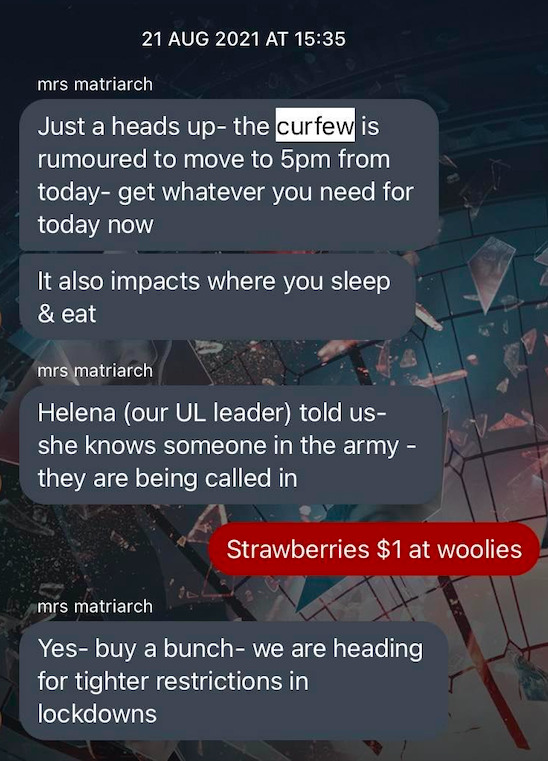
2021-08-21
This is a screenshot of a family text conversation in August 2021. The mother, nicknamed “mrs matriarch” on the Facebook Messenger application, is relaying rumours of an intensification of the lockdown restrictions, including the involvement of the military. She also encourages the popular practice of hoarding or panic buying.
This conversation encapsulates popular anxiety around the suddenness of government responses to the pandemic. The user alerts their family based on a rumour that the 8pm Victorian curfew would be moved earlier to 5pm. In hindsight, the 5pm curfew never eventuated. Instead, the 8pm curfew became 9pm, before it was later removed. The user’s fear that the military would be involved further shows the anxiety felt by Victorian residents and the sense of entrapment.
The conversation also indicates the popular phenomenon of panic buying and hoarding. The text reads, “get whatever you need for today now” and “buy a bunch – we are heading for tighter restrictions in lockdowns,” even for a perishable item like strawberries. Rumours had a very real effect on the population, prompting atypical economic behaviours, including the infamous toilet paper hoarding. The low price of strawberries reported by the user also illustrates the strange supply and demand for groceries during the pandemic and excess of fruit that year.
-
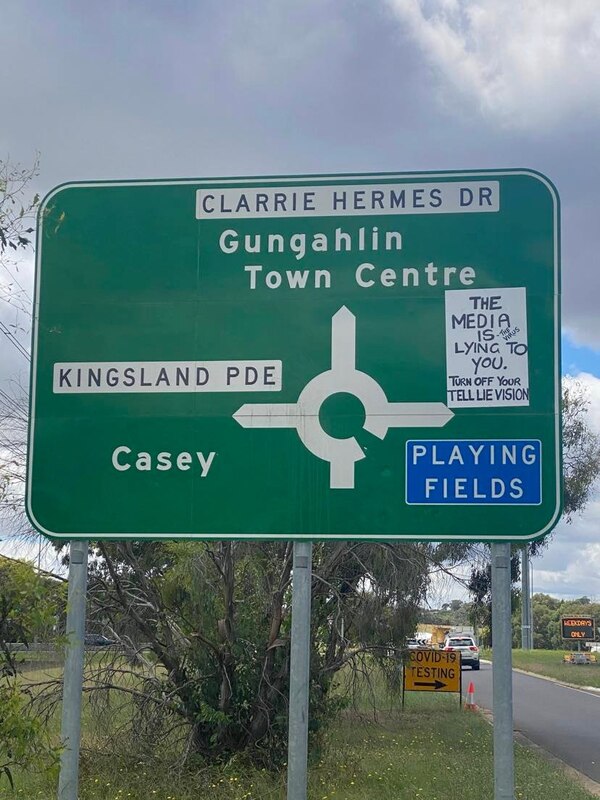
2022-02-04
This photograph depicts negative popular responses towards public messaging about the pandemic. On the Canberran road sign, a sticker reads, “The media is (the virus) lying to you. Turn off your tell lie vision.” At the bottom of the corner, a sign points towards a PCR test centre. This photograph was taken in February 2022.
It is likely that this sticker was posted by a Freedom Rally protester. In January 2022, the Freedom Rally attracted thousands of protesters to Canberra in protest of the government’s response to the pandemic. The “Canberra Convoy” drove from all parts of the country to protest in front of parliament house. While the protesters’ concerns primarily revolved around the vaccination mandate and media censorship, the movement evolved to include all manner of political concerns, including housing affordability, the rising mental health crisis, religious freedoms et cetera.
This photograph illustrates how the government measures and media coverage of the pandemic were not universally accepted but rather hotly contested in some places. The Freedom Rally, for example, attracted over 100,000 people to the nation’s capital. The photograph further shows popular anger towards the media coverage of the pandemic. The Australian Broadcasting Channel in particular attracted the ire of the anti-vaccination and anti-mandate movement for contributing towards increased fear of the virus and support for the vaccine.
-

2020-08-07
This is a photograph taken of a queue to enter a food relief centre in South Melbourne in August 2020. The queue was several hundred metres long.
As lockdowns began to ravage Melbourne, most businesses were forced to close, resulting in many people losing their jobs. Where this food relief centre had services around 100 people at the start of 2020, this number swelled to over 2000 by the height of the pandemic.
Among the most vulnerable demographics affected by the pandemic restrictions were international casual workers and students. Where citizens were eligible to apply for various emergency relief payments, such as Job Keeper or Job Seeker, migrants did not have access to these resources. This food bank only required a form of identification to register the recipients.
Several pandemic related restrictions are shown in this picture. The recipients are socially distanced, standing on makeshift markings spaced 1.5 metres apart by government restriction. They wear masks; a government requirement both indoors and outdoors at the height of the pandemic in Victoria. The food bank volunteers wear neon orange high-visibility vests and hold QR codes for the recipients to register on their own devices. I have volunteered at the food relief centre since 2020, performing the same role as the volunteers in the photograph.
Where mainstream historical narratives and media may focus on how the lockdowns affected citizens, it is important to remember how migrants too were affected by the pandemic and had little to know support from the Australian government.
-

2020-08-18
This is a screenshot of a negative PCR test result from August 2020. At this time, test results would typically take 24 hours to process, with the government requiring that the patient isolate until they received the result of their test.
I, like most residents in Melbourne, suffered a profound emotional impact from the bombardment of public messaging about the pandemic. The advertising campaigns by the state government as well as opinions expressed on social media suggested that a failure to follow health protocols would result in tremendous negative effects. For example, failing to get tested could be the reason that someone's grandmother died from exposure to the pandemic. With such high stakes attached to my everyday behaviour and compliance to health orders, whenever I felt even slightly unwell, it would trigger a barrage of intense anxiety. The health order to self-isolate for a week after a positive test result, as well as the Andrews governments' policy of reopening contingent on the number of positive test results in the community, further increased anxiety around any form of cold symptoms.
To the day, this image evokes feelings of fear and relief. Something so mundane as a text message represented either a ticket to freedom or a binding health order. In this case, the text message represented a reassurance that my sickness was the regular, boring sort, and that I was not an accidental killer of grandmothers. It represents the use of everyday technology, both sophisticated and mundane, in the pandemic response.
-
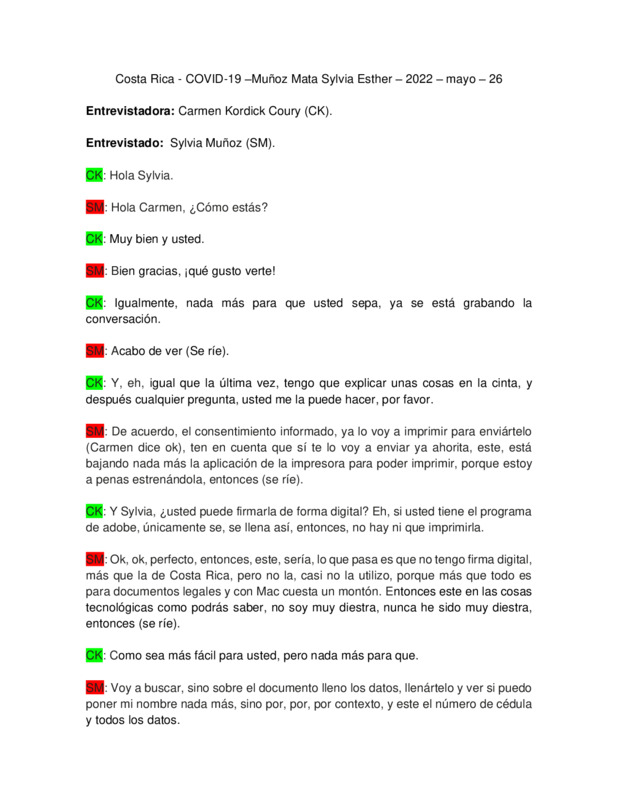
05/26/2022
En esta entrevista Silvia Muñoz Mata es entrevistada por Carmen Kordick Coury concerniente al covid-19 en Costa Rica. Para empezar, Silvia habla de las cosas que habían cambiado desde el año anterior. Habla de su hogar y como se sintió cuando se enfermó. De la vacuna, teorías conspirativas, y del gene antivacunas incluyendo su novio. De allí, Silvia habla de su trabajo, de la salud mental, el abuso y violencia doméstica. Hablan de cuestiones sociales y el tema de la economía, gente sin trabajo y inflación. Pasan el tema de la inflación, la política, las elecciones y los candidatos. También hablan del gobierno, pensiones de lujo, hospitales y salud y el uso de las mascarillas. Para terminar, hablan de las fuentes principales de información y del futuro.
-
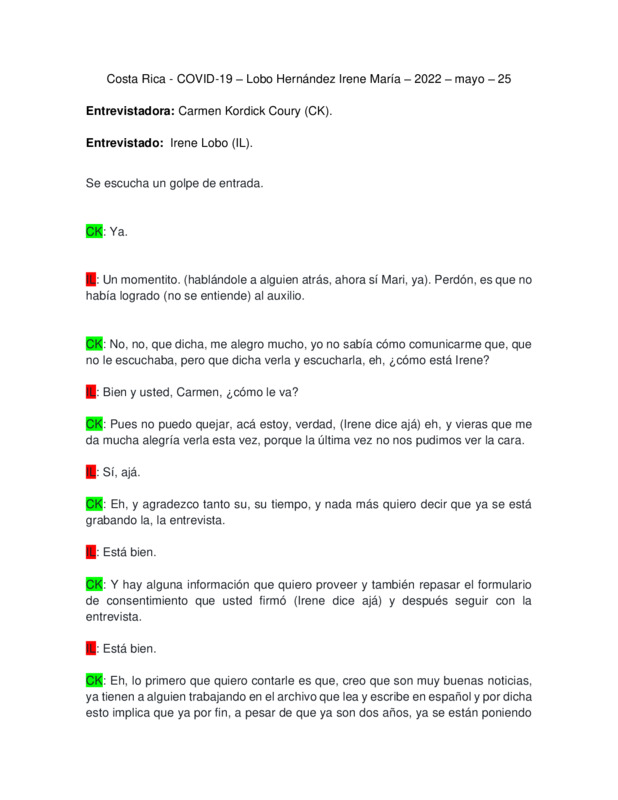
05/25/2022
En esta entrevista Irene Lobo Hernández es entrevistada por Carmen Kordick Coury concerniente al covid-19 en Costa Rica. Para empezar, hablan de lo que ha cambiado desde el ano anterior. Habla de su trabajo de abogada, del desempleo y la economía. Irene también habla del gobierno, de las vacunas y de gente que no confía en las vacunas. Habla de las elecciones y los candidatos. De gente conocida que se han enfermaron y unos que han fallecido por la pandemia. Irene también habla de las formas de celebrar la vida de su hermana que falleció el año anterior, habla de su familia y el uso de las mascarillas. Para terminar, habla de sus fuentes principales de información, la información falsa y sus deseos para el futuro.
-
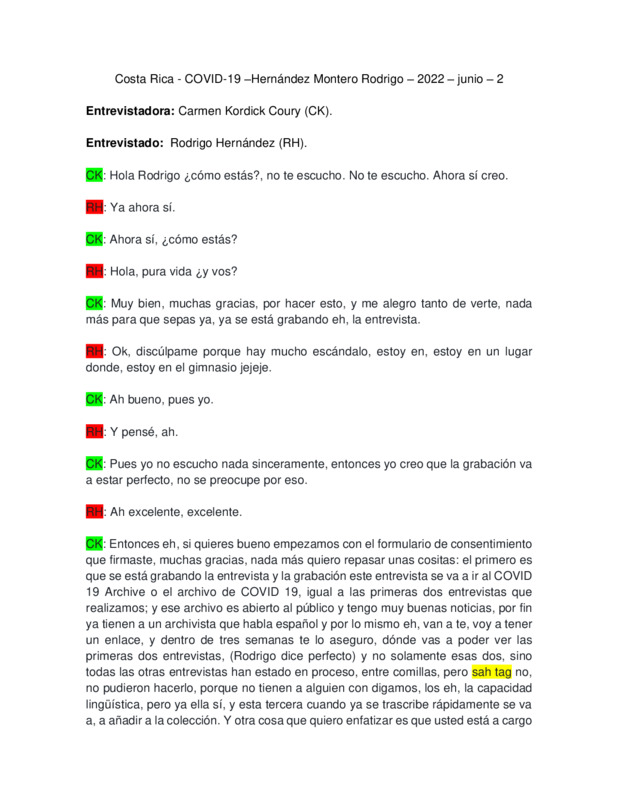
06/02/2022
En esta entrevista Rodrigo Hernández Montero es entrevistado por Carmen Kordick Coury concerniente al covid-19 en Costa Rica. Empiezan con que había cambiado desde el ano anterior. Hablan del gobierno, de la vacuna y su experiencia cuando el se vacuno. Habla de sus compañeros que aún no se habían vacunado y de como le fue a su familia cuando se enfermaron del covid. Rodrigo también habla de la caja, describe su trabajo de odontólogo, habla de sus pacientes y del uso de equipo de protección. Habla de sus compañeros del trabajo y su vida social. De la economía, la inflación y la pobreza, De allí, Rodrigo habla de su hogar y familia, del uso de la mascarilla y de las fuentes de información. Para terminar, habla de las elecciones y del futuro.
-
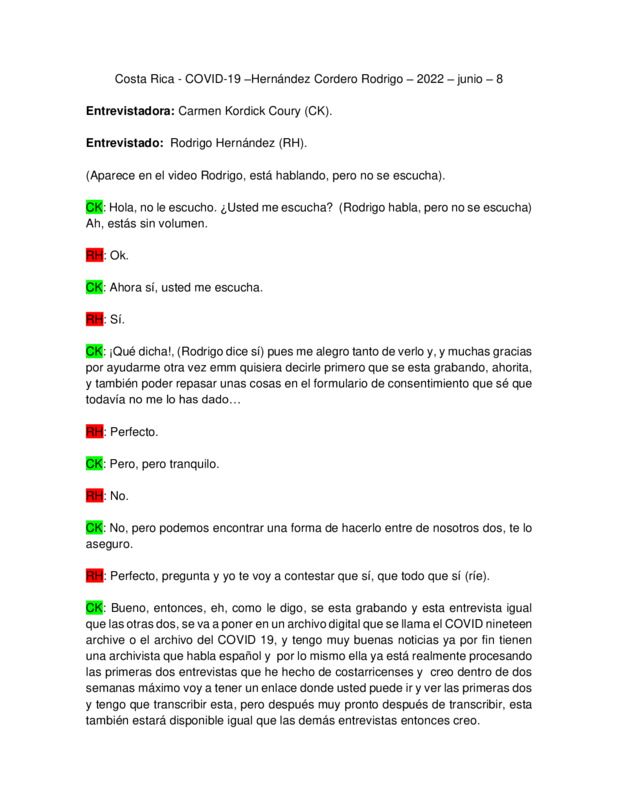
06/08/2022
En esta entrevista Rodrigo Hernández Cordero es entrevistada por Carmen Kordick Coury concerniente al covid-19 en Costa Rica. Para empezar, hablaron de cosas que han cambiado desde el ano anterior. Hablaron de su negocio, inflación, y el gobierno. De allí hablaron del gobierno, la vacuna, y la mascarilla. Hablaron de La Caja, su vida social, y su familia. De las elecciones, fuentes principales de noticias y estudios cerebrales. Para terminar, hablaron de la juventud y de sus pensamientos del futuro.
-
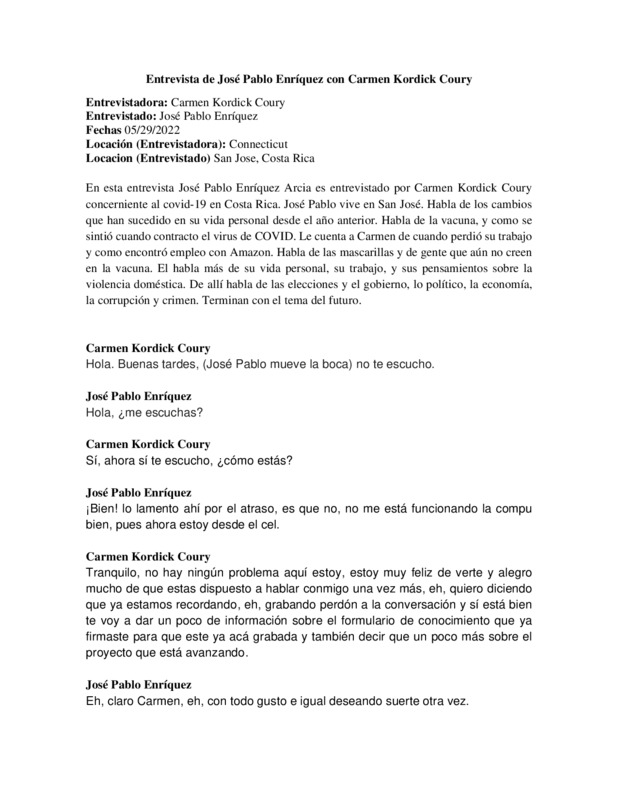
05/29/2022
En esta entrevista José Pablo Enríquez Arcia es entrevistado por Carmen Kordick Coury concerniente al covid-19 en Costa Rica. José Pablo vive en San José. Habla de los cambios que han sucedido en su vida personal desde el año anterior. Habla de la vacuna, y como se sintió cuando contracto el virus de COVID. Le cuenta a Carmen de cuando perdió su trabajo y como encontró empleo con Amazon. Habla de las mascarillas y de gente que aún no creen en la vacuna. El habla más de su vida personal, su trabajo, y sus pensamientos sobre la violencia doméstica. De allí habla de las elecciones y el gobierno, lo político, la economía, la corrupción y crimen. Terminan con el tema del futuro.
-
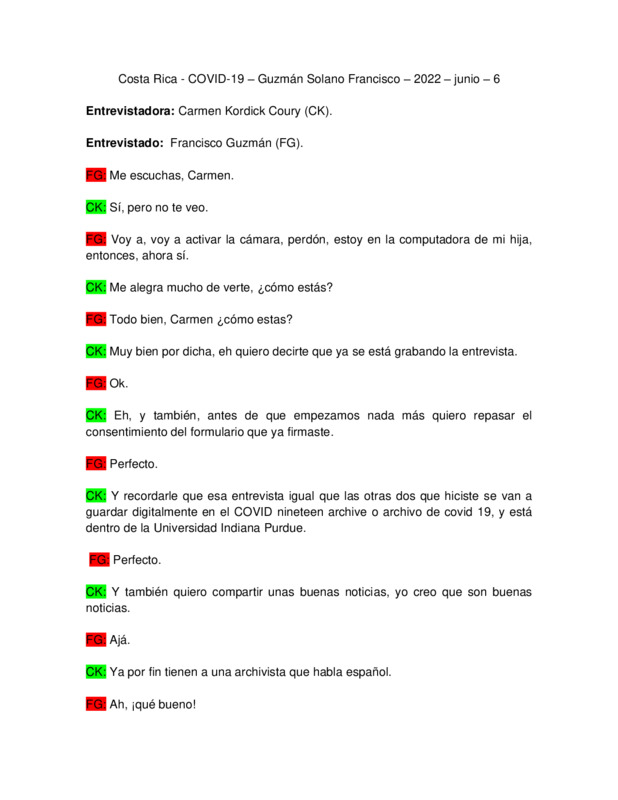
06/06/2022
En esta entrevista Francisco Guzman Solano es entrevistada por Carmen Kordick Coury concerniente al covid-19 en Costa Rica. Empiezan con los cambios que había pasado desde el ano anterior. Francisco habla de su familia y vida social. Hablan del uso de las máscaras, vacunas y la información falsa. De allí, hablan de la economía y la inflación, del gobierno y las elecciones. Hablan del crimen y las drogas. Para terminar, hablan de las fuentes principales de noticias y el futuro.
-

05/23/2022
En esta entrevista Danitza Guzman Solano es entrevistada por Carmen Kordick Coury concerniente al covid-19 en Costa Rica. Hablan de los cambios que han ocurrido desde el año anterior. Hablan del ministerio de educación, de sus estudiantes y de las mascarillas. De la salud mental, el estado mental de sus estudiantes y como van en sus estudios. Danitza también habla de la información falsa y el gobierno. Habla de su familia, su comunidad y su vida social. También hablan de la economía y fuentes de información donde ella recibe sus noticias. Para terminar hablan de las elecciones, lo político, y el futuro.
-
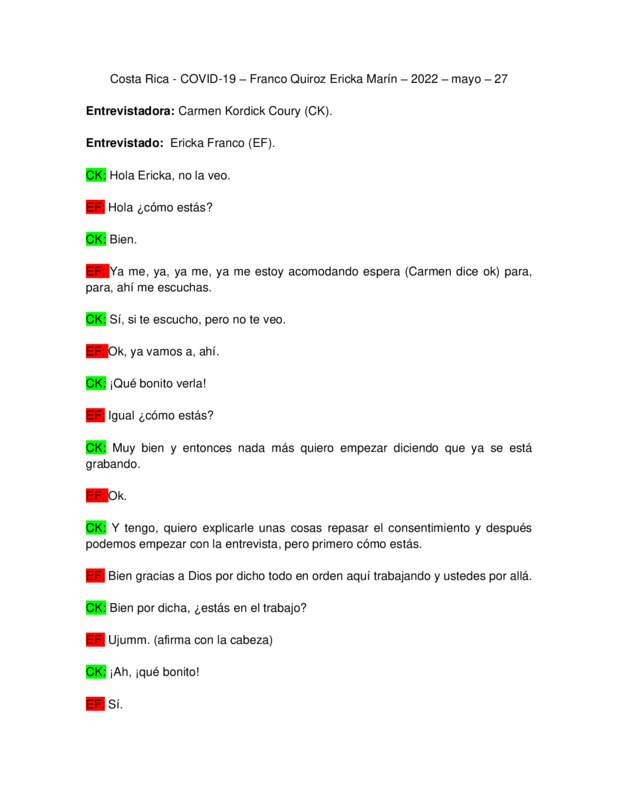
05/27/2022
En esta entrevista Erika Franco Quirós es entrevistada por Carmen Kordick Coury concerniente al covid-19 en Costa Rica. Hablan de los cambios que habían pasado desde el año anterior y cuenta que ella empezó ir al trabajo presencialmente tiempo completo. Habla de las vacunas y mascarillas. Erika habla de su trabajo como orientadora para un colegio técnico profesional y también habla de los estudiantes. De allí, ella habla del gobierno, cuenta que ella contracto COVID, y habla de la gente que no se quiere vacunar. Habla de su vida social, fuentes de información donde ella se educa, y la economía. Para terminar, ella habla de las elecciones, salud mental y el futuro.
-
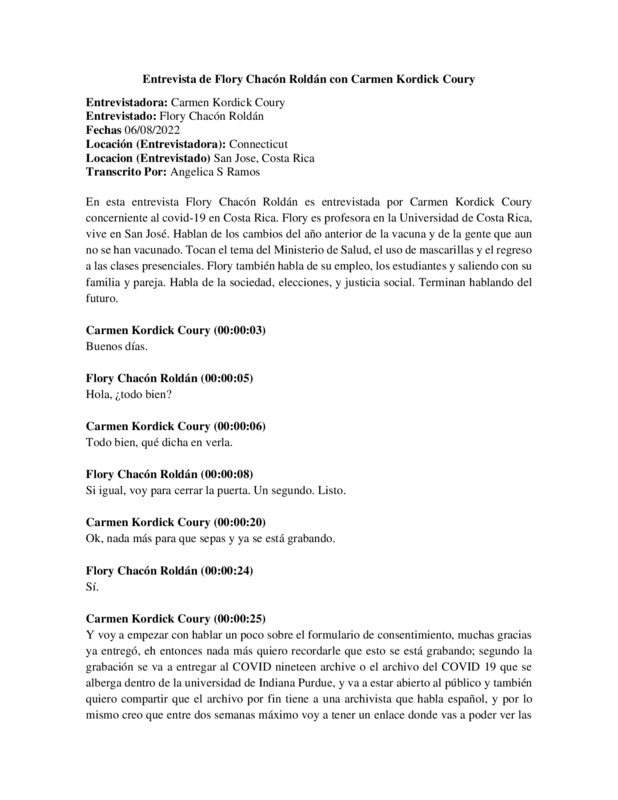
06/08/2022
En esta entrevista Flory Chacón Roldán es entrevistada por Carmen Kordick Coury concerniente al covid-19 en Costa Rica. Flory es profesora en la Universidad de Costa Rica, vive en San José. Hablan de los cambios del año anterior de la vacuna y de la gente que aun no se han vacunado. Tocan el tema del Ministerio de Salud, el uso de mascarillas y el regreso a las clases presenciales. Flory también habla de su empleo, los estudiantes y saliendo con su familia y pareja. Habla de la sociedad, elecciones, y justicia social. Terminan hablando del futuro.
-
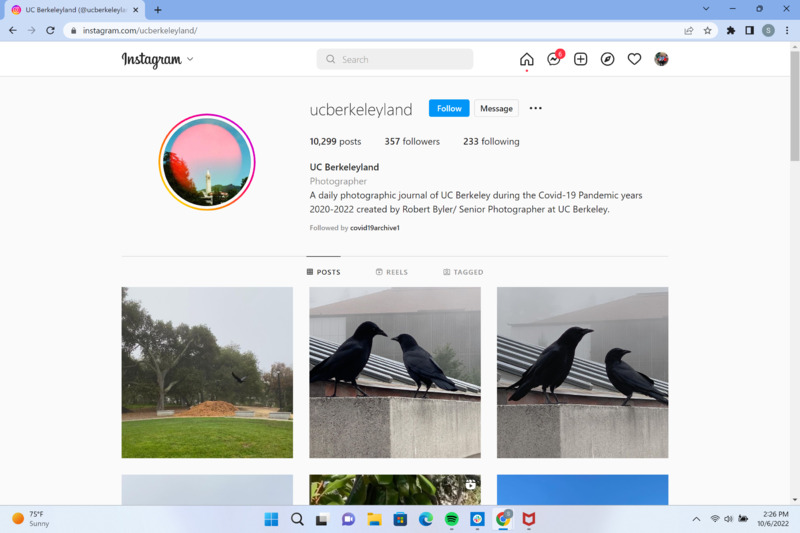
2020-01-01
Daily photographic journal golf UC Berkeley during the Covid-19 Pandemic years 2020 through 2022
-
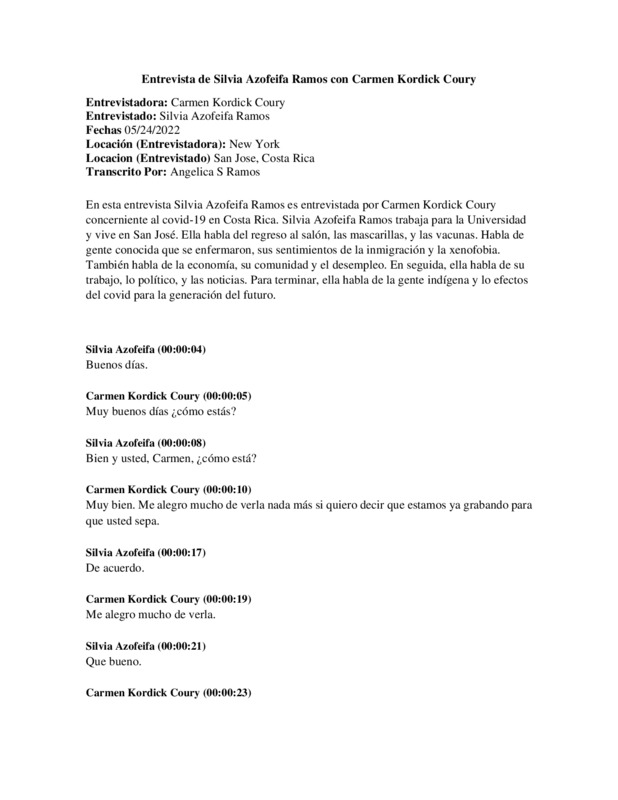
05/24/2022
En esta entrevista Silvia Azofeifa Ramos es entrevistada por Carmen Kordick Coury concerniente al covid-19 en Costa Rica. Silvia Azofeifa Ramos trabaja para la Universidad y vive en San José. Ella habla del regreso al salón, las mascarillas, y las vacunas. Habla de gente conocida que se enfermaron, sus sentimientos de la inmigración y la xenofobia. También habla de la economía, su comunidad y el desempleo. En seguida, ella habla de su trabajo, lo político, y las noticias. Para terminar, ella habla de la gente indígena y lo efectos del covid para la generación del futuro.
-
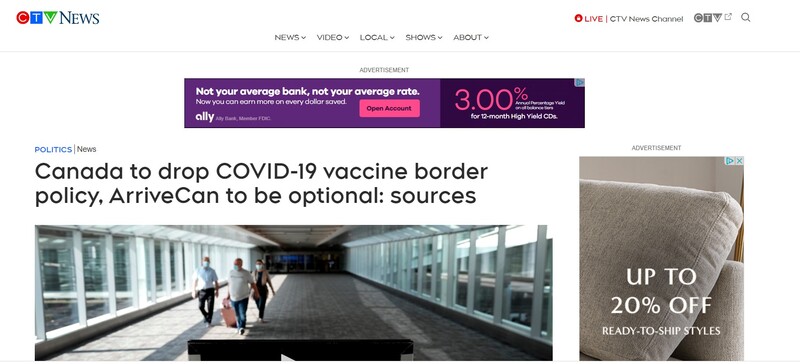
2022-09-21
This news article reports Canada's plan to drop its COVID-19 vaccine border requirements, make the ArriveCan application optional, and possibly end COVID-19 testing for travelers by the end of September 2022. This news shows how the COVID-19 pandemic impacted travel and border relations between countries (Canada and US).
-
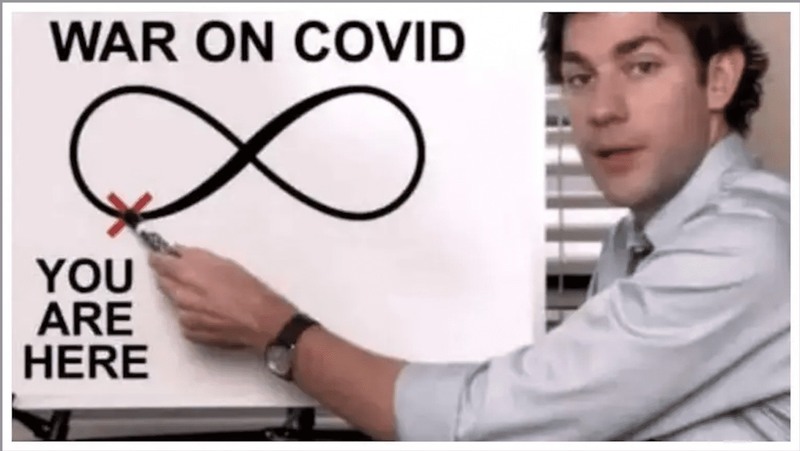
2022-02-02
The image describes the cyclical nature that came with the Coronavirus due to various variants developing. This repetition can lead to people living stagnant and restricted lives. Such occurrences may result in feelings of hopelessness and futility. Sadly, one person alone cannot stop the spread of the virus, yet individuals continue to suffer.
-
2022-08-30
Political divisions greatest threat to U.S.; 7 Billion weapons left in Afghanistan; Opioid $ penalties; $300 billion college loan forgiveness; college tuition up 6x inflation; 16% of voters would not have voted for Biden; election not stolen at voting booth; Democrats gaining fast on midterm elections; Trump welcomes embrace of QAnoners
-
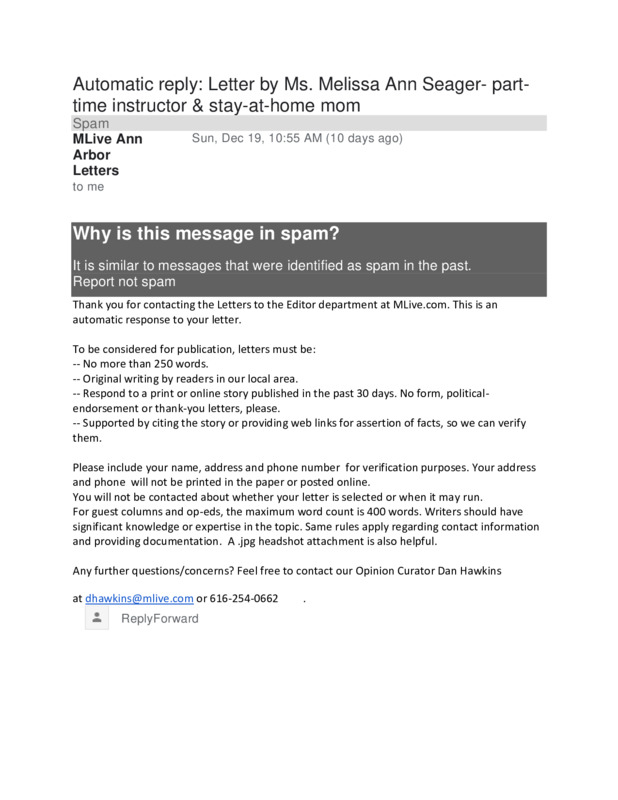
2022-09-10
• I am by Profession a Part-time Instructor of Creative Writing. I received my master’s degree in creative Writing from Concordia University. Right now, sine the Coronavirus crisis hit, I have been a full-time Stay-at-Home Mom with our two lovely daughters, Emily 8 and Lisa 10! They have been having the hardest time since the Coronavirus Situation hit our Country. Many times, Emily will say to me ‘Mommy, I’m scared, when will this crisis end? I’m Sorry, because I really don’t know what to say to her, at that age!! When I was a little girl, we didn’t have to face such a crisis! The closest thing we had was in 1961, to hide under our school desks, during siren drills!
• Mentally, lately I have, personally been having frequent bouts of Severe Depression, whereby I feel like crying a lot, but my daughters and my husband, Dennis, kisses me, comforts me and tells me not to Worry!!
• My Father-in-Law has recently been admitted to the hospital, after he began having severe stomach pains, after helping my Mother-In-Law to lift several boxes of heavy furniture! He was in the hospital for a series of Tests, after which it was discovered that he had damaged his Kidneys and 1-2 months of Intense Physical Therapy, combined with daily Anti-Biotics!
A Group of Ladies that I belong to at my Church, have been commenting, “Boy Melissa, you simply don’t seem like your Cheerful, jolly, Loving self, are you sure you are alright?? Is there anything that We can do to help you and Dennis?
• I typically work Outside-the-Home, but lately, because of our two daughters, I have chosen to work remotely from Home! But their smiles 😉 make it all worthwhile!!
• My Husband and I are both, definitely practicing Social Distancing!! My girlfriends All Admire the ‘Courage-Of-My-Conviction!’ They tell Me Openly that they feel that I AM TRULY ONE OF THE BRAVEST WOMEN THAT THEY KNOW!! Although Dennis and I have to frequently visit his parents only via Skype! This is often-times distressing!
• Because of this, We hardly-Ever, if Ever, Go Outside Our Home, so We have had to cancel Running of All Errands, and We absolutely do no Travelling and Outside trips, (Except the get-the-mail), and So we Obviously pursue All of Our Leisure, Social Activities, and all such Celebrations like Thanksgiving, and Christmas, on-line via Zoom!
• Personally, I Definitely think that the Government could have done a lot more in the wake of this Covid-19 GLOBAL PANDEMIC. Of course, I am relieved now that we are going to have a Wonderful New Administration in Washington, D.C.! I just hope to-GOD THAT THEY DO NOT “TAKE THEIR EYES OFF THE BALL!!”
• As the Mother of two young girls, it pains me very much so just think about ‘what kind of future my daughters are going to have, if we fail once again to ‘Nip this crisis in the bud’?
• Definitely, I am hopeful that as a World Community, we will all be coming much closer together!! This makes me smile too!
-

2020-10-08
Students all over Australia experienced struggles with the pandemic affected learning environments, one of the most challenging at the a University of Melbourne was the use of Zoom calls for learning and how it impacted motivation to learn and overall fatigue.
-
2020
Our adult son died of cancer at the end of 2018. We were devastated. Our lives were disrupted and upended, while everyone else went on as if everything was normal. Anyone who has lost a family member or friend knows what this is like.
Way too many people found out in 2020 what that is like. In 2020, other people were inconvenienced. A lot. I’ll acknowledge that it was tough on everyone, but it’s nothing compared to losing a loved one. When we realized that the pandemic disruption really didn’t faze us, we realized that we were going to be OK. We had faced the unbearable; this was trivial by comparison. So was losing my job. We were privileged that 2020 and 2021 gave us a chance to reset, to recharge, to reboot. To make ends meet, I now work and live on another continent, away from my wife. It’s incredibly difficult. We’ve dealt with worse situations. We’ll be OK.
-

2020-08-11
The American response to the global COVID-19 Pandemic was multi-faceted. However, of specific importance to the nation were the changes made to public education. As the Pandemic resulted in the closure of businesses, teachers and students were required to continue their educational programs online from the privacy of their homes. Although the effects of distance learning will continue to be seen, virtual learning severely limited the ability of students and teachers to use sensory perception as a tool for learning and instruction.
First, distance learning no longer enabled American teachers to utilize the sensory perception of “proximity.” Throughout public education “proximity” is used to encourage student engagement with both instruction and content. Many teachers will walk their classrooms during student activities and use sensory perception to sensorially inform students that they are near to them and are assessing their engagement. Teachers use this strategy as a reinforcement tool to develop students’ ability to stay on task. Yet, during the COVID-19 Pandemic, social distancing policies made “proximity” not only impossible, but also illegal, limiting to what extent teachers could use sensory perception to foster engagement and learning.
Second, not only were educators no longer allowed to use the sensory perception tool of physical proximity, but also many educators were forced to rely solely on the sensory perception of sound. School districts throughout the state of California, for example, did not permit educators to require their students to verify their attendance in live video format. The result was educators and students were engaging predominantly through speaking and listening. Furthermore, being denied the sensory perception of sight, educators could not assess to what extent students were engaging with instruction and activities.
In conclusion, the COVID-19 Pandemic enacted emergency response strategies which directly affected the education of Generation Z. For both students and educators, sensory perception became more limited for every student. Yet, the sciences, including social science, are built upon the empirical information a human being receives through them. Perhaps this video will serve as evidence to answer the question, “To what extent were students denied the right to sensory information and science?”
 2020-03-31
2020-03-31 05/25/2022
05/25/2022 2022-10-23
2022-10-23 2022-10-20
2022-10-20 2022-10-10
2022-10-10 2022-10-10
2022-10-10 2022-01-02
2022-01-02 2020-06-06
2020-06-06 2021-09
2021-09 2021-08-28
2021-08-28 2020-07-04
2020-07-04 2021-10-20
2021-10-20 2020-12-01
2020-12-01 2020-03-20
2020-03-20 2021-09-18
2021-09-18 2022-10-31
2022-10-31 2021-10-22
2021-10-22 2022-10-30
2022-10-30 2021-08-08
2021-08-08 2021-09-16
2021-09-16 2021-09-15
2021-09-15 2020-04-05
2020-04-05 2021-07-23
2021-07-23 2020-04-04
2020-04-04 2021-08-21
2021-08-21 2022-02-04
2022-02-04 2020-08-07
2020-08-07 2020-08-18
2020-08-18 05/26/2022
05/26/2022 05/25/2022
05/25/2022 06/02/2022
06/02/2022 06/08/2022
06/08/2022 05/29/2022
05/29/2022 06/06/2022
06/06/2022 05/23/2022
05/23/2022 05/27/2022
05/27/2022 06/08/2022
06/08/2022 2020-01-01
2020-01-01 05/24/2022
05/24/2022 2022-09-21
2022-09-21 2022-02-02
2022-02-02 2022-09-10
2022-09-10 2020-10-08
2020-10-08 2020-08-11
2020-08-11